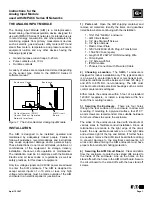
218
(MT11 - Gb2012)
Check that the connections of the system
are carried out correctly.
Put the system in use by connecting the
power supply to the mains.
By pushing a call button from the external
push-button panel, the call is sent to the
corresponding video intercom, the system
is activated for about 50 seconds (100 sec-
onds with 1281E power supply-timer) and
the image appears on the monitor a few
seconds after the call.
By lifting the handset, the called user can
speak with the external station and increases
at the same time the activation time of the
system (about 3 minutes) (feature not avail-
able for 1281E power supply-timer).
If a call to another internal station occurs in
the meantime, the monitor switches OFF
and the last monitor called is activated.
By using 1281 power supply and 1282E
timer, the installation can be switched OFF
by replacing the handset or at the end of the
timing; by using 1281E the installation can
be switched OFF only at the end of the
timing.
By making a call to a video intercom with off-
hook handset, the monitors is activated with-
out hearing the ringing call.
If more calls occur simultaneously, a pro-
tection circuit against overloading and short
circuiting is provided to disable the timer
and switch OFF the system. If provided for in
the system, from any monitor it is possible to
control the entrance by pressing the
but-
ton (control switch ON). It is not possible to
make this control using 1281 power supply
together with 1282E timer during a conver-
sation. Vice versa using 1281E power sup-
ply-timer the control switch ON is always
possible.
To operate the electric door lock release
press the
button.
In systems with 2 or more entrances, audio,
video and door lock release switching be-
tween two entrances is automatic upon the
call or control switching ON.
In systems with 2 or more entrances, the
control switch ON from the monitors inter-
rupt the communication in progress, conse-
quently in multi-way systems it is advisable
to interrupt during a communication the
switch ON function by means of a relay art.
1471 or 1472, giving the priority to the com-
munication to the external door stations (see
installation diagrams of video intercom sys-
tems with several entrances).
In systems with intercommunicating service,
the communication between monitors and/
or intercoms is possible only when the sys-
tem is in stand-by.
Adjustments
Being subject to the environmental lighting
conditions, contrast and brightness can be
adjusted by means of external knobs.
All the other adjustments can be carried out
inside the monitor. For any necessary main-
tenance intervention of a specialized tech-
nician is mandatory.
WORKING INSTRUCTIONS
The probability of breakdown in the video-intercom
systems is obviously greater than in the intercom
system. Consequently this brief troubleshooting
takes into consideration the most common de-
fects. When a defect is limited to only one
videointercom it is evident that the trouble is a short
circuit to the videointercom itself, to the connecting
terminal board or to the wires that go to the riser.
The simplest way to test the efficiency of a
videointercom is to connect it in another flat where
everything functions correctly.
Preliminary checks
- Check for the presence of the mains voltage
between terminals 230 (or 127) and 0 of the
power supply.
- The power supply is not provided with fuses, but
all of its outputs are protected against overload-
ing and short circuiting by temperature sensors.
To reset the power supply, power must be cut
OFF for about one minute and can be restored
after having eliminated the problem.
- Check the voltage output of the power supply
(see in detail the values indicated in the power
supply and control chapter-page 142).
- Check that the cross section of the wire corre-
sponds to what is indicated on page 146 and on
the descriptions of each diagram.
- Check that the connection of the wire corre-
sponds to the installation diagram.
Problem, reason and solutions
Videointercoms shut OFF. Ringing tone not
present. Control switching ON not function-
ing.
Absence of main voltage. Short circuits or over-
loading of the output terminals of the power supply
and/or timer. Faulty power supply. Faulty timer.
Videointercoms shut OFF. Ringing tone not
present. Control switch ON functioning.
The C+ wire is interrupted. Faulty timer.
Videointercoms turn ON. Absence of image.
The wire H that powers the camera is interrupted.
The coaxial cable is interrupted or has a short
circuit. The shield of the coaxial cable is inter-
rupted. The video distributors (if present) are not
being powered. Faulty camera unit.
Control switch ON by videointercoms does
not function.
Wire 4 is interrupted. Faulty timer. The system is
working.
The system does not shut OFF by replacing
the handset.
Such a defect can be due to the non-working audio
section from the door station to the videointercoms
(see related section). Faulty timer. Faulty electric
door speaker.
Unfocused image.
Dirty optics or lens. Faulty camera.
Image only slightly contrasted and/or out of
synchronism.
Bad quality of coaxial cable or coaxial cable in
dispersion. Nominal impedance of coaxial cable
not of 75
Ω
. High distance system (use video
amplifier art.476). Check the correct connection of
the coaxial cable (see pages 147 and 148).
TROUBLESHOOTING
The electric door lock does not function.
Faulty lock. The cross section of the wires indi-
cated in bold type is insufficient. A connecting wire
to the lock has been interrupted. The 5 wire is
interrupted. Faulty timer.
Audio section
No audio from both channels.
Absence of power supply voltage between 3 and 4
of the electric door speaker (6÷8Vdc). Short circuit
between 3 and F of the timer. The 3D wire is
interrupted. Faulty timer.
No audio from the videointercoms to the door
station.
The 1D or 1 wire (from the timer to the door station)
is interrupted or has a short circuit. Absence of the
ground connection to terminal 4 of the electric door
speaker (amplifier). Faulty electric door speaker.
No audio from the door station to the
videointercoms.
The 2D or 2 wire (from the timer to the door station)
is interrupted or has a short circuit. Defective elec-
tric door speaker (amplifier).
Audio with humming in the background (50/
60Hz).
The wires have been canalized together with the
cables that power AC loads. Separate the ground
connection of the electric door speaker (amplifier)
and of the name plate lights, or power them with an
additional transformer (see recommendations on
page 146). Faulty power supply.
A whistle is heard at the external door station
(Larsen effect).
The microphone hole of the external door station
might be clogged. Lower the volume.
Radio reception on the door station.
The defect can occur when there is a transmitter
working in the proximity. Apply a capacitor from
0.1µF between terminals 1 and 3 of the electric door
speaker (amplifier).
Intercommunicating systems
During the intercommunication the door
speaker is still connected.
The video system is ON (privacy towards the
outside only when the video system is in standby).
The module for intercommunicating has not been
plugged in the timer art.1443E. Faulty timer.
No audio in the intercommunicating service.
The wall-brackets of the videointercoms have the
J1 jumper in position of audio privacy. Defective
module for intercommunicating. Faulty timer.
The intercommunicating calls does not work.
Faulty timer. Check that wire 7 is connected cor-
rectly. Check the button connections inside the
intercoms.
System with more entrances
Entrance A is never activated.
Short circuit between 5 and 6 of the exchanger.
Faulty exchanger.
Entrance B is never activated.
Short circuit between 3 and 4 of the exchanger.
Faulty exchanger. No power supply to 1 and 2 of the
exchanger (12Vac; 17÷21Vdc).
4+1
INTERCOMS *
7+1
VIDEOINTERCOMS















































